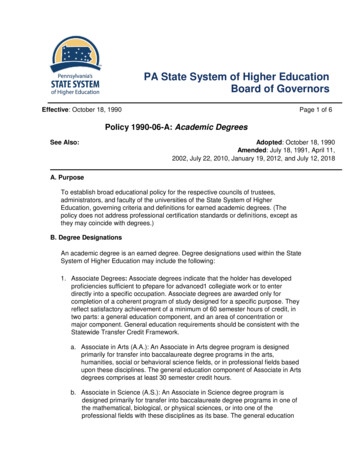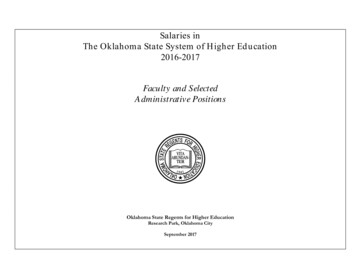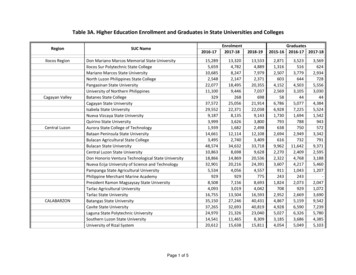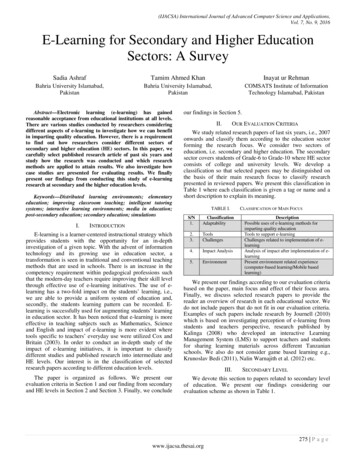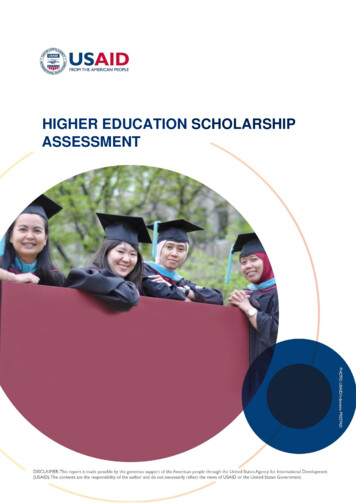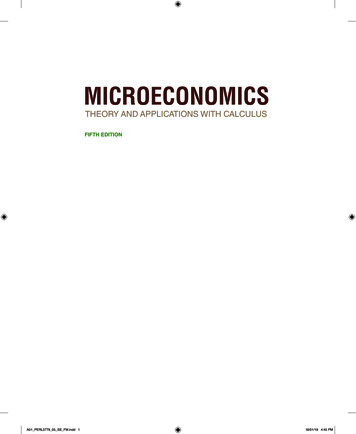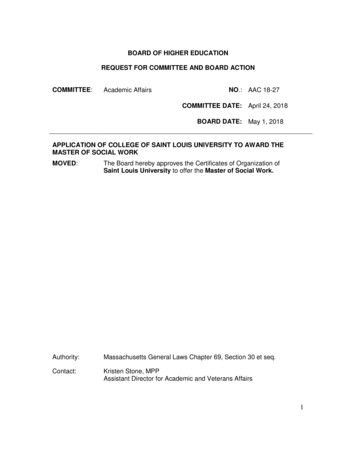
Transcription
Higher Education FundingOverview of Formula Funding for All InstitutionTypes, Small Institution Supplement Funding &the Available University Fund and HigherEducation FundPRESENTED TO JOINT INTERIM COMMITTEEON HIGHER EDUCATION FORMULA FUNDINGLEGISLATIVE BUDGET BOARD STAFFFebruary 2018
Overview of PresentationRelated to General Appropriations Act, Article III Special Provisions Sec. 62. NonFormula Support Items and Formula Study. Overview of Formula Funding Mechanics and Methods of Finance Overview of General Academic Institution (GAI) Formulas Overview of Lamar State Colleges (Lamars) and Texas State Technical College(TSTC) Formulas Overview of Health Related Institution (HRI) Formulas Overview of Public Community and Junior Colleges Formulas Overview of Small Institution Supplement Funding Overview of the Permanent University Fund and the Higher Education FundFEBRUARY 21, 2018LEGISLATIVE BUDGET BOARD ID: 51862
General Formula Funding Mechanics Formulas are a distribution method for higher education funding. Higher educationformulas do not create a statutory or constitutional entitlement.Formula Method of Finance. General Academic Institutions, Health Related Institutions, Lamar State Collegesand Texas State Technical Colleges are funded through an All Funds methodologywhich means that General Revenue and GR-Dedicated–Other Educational andGeneral Income (E&G) are used to fund these formulas. “Other E&G” includes revenue generated by statutory tuition, interest on funds in thestate treasury, and various fees. (Board Authorized Tuition is distributed afterformula calculation, therefore does not affect the amount of General Revenue.)Other E&G Set Asides. Some E&G income is set aside for specific purposes. Specificamounts are unavailable for formula purposes and, consequently, as a formula methodof finance. For example, institutions set aside a portion of their tuition to provide TexasPublic Education Grants.FEBRUARY 21, 2018LEGISLATIVE BUDGET BOARD ID: 51863
General Academic InstitutionsInstruction and Operations Formula The General Academic Institution (GAI) Instruction and Operations (I&O) Formula isbased on Semester Credit Hours (SCH) during a three-semester base period. SCH is ameasure of how many classes an institution delivers. The base period used for the 201819 biennium is Summer and Fall of 2016 and Spring of 2017. SCH are weighted by discipline (e.g. nursing is weighted more than liberal arts) and bylevel (lower and upper division, masters, doctoral, and professional). The weights arebased on an expenditure study completed by the Texas Higher Education CoordinatingBoard of relative costs and are listed on the following slide. The Legislature sets the rate based on available funding, including consideration ofenrollment changes and other factors.Semester Credit HoursXProgram/Level WeightXRate ( 55.82) Hours taught by tenured or tenure-track faculty qualify for the teaching experiencesupplement. The weight functions as it does in the Instruction and Operations formula.Semester Credit Hours X Program/Level Weight X Supplement (0.10) X Rate ( 55.82)FEBRUARY 21, 2018LEGISLATIVE BUDGET BOARD ID: 51864
General Academic InstitutionsCost Based MatrixLOWER DIVISIONUPPER DIVISIONMASTERSDOCTORALLiberal Arts1.001.734.0110.90Science1.642.817.0420.70Fine Arts1.462.516.077.48Teacher neering2.153.225.5017.15Home Economics1.111.762.799.09Law4.77Social Services1.571.892.4719.33Library Science1.441.543.3514.64Vocational Training1.162.74Physical Training1.461.26Health 32.174.23Business Admin1.161.833.2624.7037.5255.92OptometryTeacher Ed 1.492.043.009.57Developmental Ed1.00Veterinary MedicineFEBRUARY 21, 2018SPECIALPROFESSIONAL7.6523.30LEGISLATIVE BUDGET BOARD ID: 51865
GAI, Lamars, and TSTCInfrastructure Formula The GAI Infrastructure Formula, which also includes the Lamar State Colleges andthe Texas State Technical Colleges, allocates funding for physical plant support andutilities and is based on predicted square feet for universities' educational andgeneral activities produced by the Space Projection Model developed by the TexasHigher Education Coordinating Board. As with the SCH rate, the Legislature sets the rate based on available funding,including consideration of changes in space and other factors.Predicted Square FeetFEBRUARY 21, 2018XRate ( 5.41)LEGISLATIVE BUDGET BOARD ID: 51866
Small Institution Supplement Additionally, institutions with a headcount of less than 10,000 students alsoreceive the Small Institution Supplement. For General Academic Institutions, thesupplement totals 1.5 million for the biennium for each institution with less than a5,000 student headcount. Institutions with headcounts that range from 5,000 to10,000 students receive an appropriation that decreases from 1.5 million witheach additional student. For the Lamar State Colleges and Texas State Technical Colleges, themethodology is similar, but the threshold for the supplement is 5,000 studentsand the maximum supplement is 750,000.FEBRUARY 21, 2018LEGISLATIVE BUDGET BOARD ID: 51867
Lamar State Colleges andTexas State Technical Colleges The Instruction and Administration (I&A) Formula for the Lamar State Colleges isbased on contact hours. A contact hour is a standard unit of measure that representsan hour of scheduled academic and technical instruction given to students during asemester. The base period used for the 2018-19 biennium is Summer and Fall of2016 and Spring of 2017.Contact Hours XRate ( 3.53) The Legislature sets the rate based on available funding, including consideration ofenrollment changes and other factors. The Eighty-third Legislature, Regular Session, 2013, modified the calculation of theTexas State Technical College (TSTC) I&A formula to base it on the returned value tothe state generated by the TSTC System rather than student contact hours. The I&Aformula now compares average student wages upon completion of nine semestercredit hours or more at a TSTC institution to minimum wage to determine theadditional value an individual generates for the state after attending a TSTC institution.Based on available funding, the Legislature then appropriates a percentage of thisreturned value amount to the TSTC System for I&A funding.Returned Value X Percentage Allocated to TSTC (27.6%)FEBRUARY 21, 2018LEGISLATIVE BUDGET BOARD ID: 51868
Formula Appropriations for General Academic Institutions,Lamar State Colleges, and Texas State Technical IN MILLIONSFormulaInstruction and Operations - GAIsFormulaGeneralRevenueAnnual AllFunds RateFormulaGeneralRevenueAnnual AllFunds Rate 2,917.1 55.39 2,870.1 55.82Infrastructure Support – GAIs, Lamars,and TSTCs551.15.62530.25.41Instruction and Administration - Lamars26.13.5327.23.53Instruction and Administration – TSTCs*94.035.5%94.027.6%Total 3,588.3 3,521.5*Percentage reflects the allocation of returned value appropriated to the TSTC System for I&A funding.FEBRUARY 21, 2018LEGISLATIVE BUDGET BOARD ID: 51869
Health Related Institutions Formulas The Health Related Institutions (HRI) Instruction and Operations Formula is basedon Full-Time Student Equivalents (FTSE) during a three-semester base period. TheFTSEs are weighted by program, and the Legislature sets the rate based onavailable funding, including consideration of enrollment changes and other factors.FTSE X Program/Level Weight X Rate ( 9,431) The HRI Infrastructure Support Formula allocates funding for physical plant supportand utilities based on the predicted square feet at the institutions. As with the I&Orate, the Legislature sets the rate based on available funding, includingconsideration of changes in space and other factors.Predicted Square Feet X Rate ( 6.11)Note: Baylor College of Medicine receives funding for its undergraduate medical students, by statute, based on theaverage cost per undergraduate medical student enrolled at The University of Texas Medical Branch and The Universityof Texas Southwestern Medical Center.FEBRUARY 21, 2018LEGISLATIVE BUDGET BOARD ID: 518610
I&O Funding by Weights and Discipline The I&O formula multiplies the number of FTSEs generated at an institution by aweight assigned to the program, regardless of level. The weights for each of theseprograms are shown in the table below. These weights are not based on a cost studyand have not changed since the inception of the formulas in 2000-01.FEBRUARY 21, 2018ProgramWeightAllied HealthBiomedical Science1.0001.018NursingPharmacy1.1381.670Public HealthDental1.7214.601Medical4.753LEGISLATIVE BUDGET BOARD ID: 518611
Health Related Institutions Formulas The Research Enhancement Formula provides support for medical and clinicalresearch of the institutions, and are allocated using a base amount plus apercentage of research expenditures from the most recent fiscal year.Base ( 1,412,500) 1.16% of Research Expenditures The Graduate Medical Education (GME) Formula provides funding on a per medicalresident basis in an accredited program.Number of Medical Residents X Rate ( 5,824)Note: Baylor College of Medicine receives Graduate Medical Education funding through the HRI GMEformula.FEBRUARY 21, 2018LEGISLATIVE BUDGET BOARD ID: 518612
Health Related InstitutionsMission Specific Formulas UTMDACC Cancer Center Operations Formula is a mission specific formula thatprovides support for UTMDACC based on Texas cancer patients served.Number of Texas Cancer Patients Served X Rate ( 1,650) UTHSCT Chest Disease Center Operations is a mission specific formula thatprovides support for UTHSCT based on the number of new primary chest diseasediagnoses in Texas each year.Number of New Primary Chest Disease Diagnoses X Rate ( 187) For each of the mission specific formulas, the amount of growth in total fundingfrom one biennium to another may not exceed the average growth in funding forHealth Related Institutions in the I&O formula for the current biennium.FEBRUARY 21, 2018LEGISLATIVE BUDGET BOARD ID: 518613
Formula Appropriations forHealth Related Institutions2016-17 Appropriations2018-19 AppropriationsIN MILLIONSFormulaInstruction and Operations*FormulaGeneralRevenueAnnual AllFunds RateFormulaGeneralRevenueAnnual AllFunds Rate 1,169.2 9,829 1,175.7 9,431246.86.65; 6.26250.16.11Research Enhancement74.61.23 percent80.61.16 percentGraduate Medical .421558.4187Infrastructure SupportCancer Center OperationsChest Disease Center OperationsTotal 1,899.6 1,919.8*Includedin these totals are amounts appropriated for Baylor College of Medicine through the Higher Education CoordinatingBoard’s bill pattern.FEBRUARY 21, 2018LEGISLATIVE BUDGET BOARD ID: 518614
Public Community and Junior Colleges Beginning in the 2014-15 biennium, the Legislature implemented a new outcomesbased model for the Instructional and Administrative formula that includes threefunding components: Core Operations Success Points Contact Hours Unlike other institutions, formula funding is funded entirely with General Revenueand does not include tuition and fee revenue as part of the method of finance.FEBRUARY 21, 2018LEGISLATIVE BUDGET BOARD ID: 518615
Core Operations andSuccess Points Funding Core Operations Each community/junior college district receives 1.4 million per biennium to helpcover basic operating costs, regardless of size or geographic location. Core Operations replaced the community college small institution supplement. Success Points ( 171.56) Funding is based on a three year average of success points earned by students ateach community college. Students are able to earn success points through eleven individual metrics.FEBRUARY 21, 2018LEGISLATIVE BUDGET BOARD ID: 518616
Success PointsMetricPoints Student successfully completes developmental education in mathematics1.0 Student successfully completes developmental education in reading0.5 Student successfully completes developmental education in writing0.5 Student completes first college-level mathematics course with a grade of "C" or better1.0 Student completes first college-level course designated as reading intensive with a grade of "C" or better0.5 Student completes first college-level course designated as writing intensive with a grade of "C" or better0.5 Student successfully completes first 15 semester credit hours at the institution1.0 Student successfully completes first 30 semester credit hours at the institution1.0 Student transfers to a General Academic Institution after successfully completing at least15 semester credit hours at the institution2.0 Student receives from the institution an associate's degree, a Bachelor's degree, or a certificaterecognized for this purpose by the Coordinating Board in a field other than a critical field, such asScience, Technology, Engineering and Mathematics (STEM), or Allied Health.2.0 Student receives from the institution an associate's degree, a Bachelor's degree, or a certificaterecognized for this purpose by the Coordinating Board in a critical field, including the fields ofScience, Technology, Engineering or Mathematics (STEM), or Allied Health.FEBRUARY 21, 2018LEGISLATIVE BUDGET BOARD ID: 51862.2517
Contact Hour Funding A contact hour is a time unit of measure that represents an hour of scheduledacademic or technical class time, 50 minutes of which must be instructional. Contact hour funding is based on each community college’s share of total weightedbase year contact hours. The base period used for the 2018-19 biennium isSummer and Fall 2016 and Spring of 2017.Contact Hours X Rate ( 2.70) The Legislature sets the rate based on available funding, including consideration ofenrollment changes and other factors.FEBRUARY 21, 2018LEGISLATIVE BUDGET BOARD ID: 518618
Formula Appropriations forPublic Community/Junior Colleges2016-17 Appropriations2018-19 AppropriationsIN MILLIONSFormulaContact HoursSuccess PointsCore FundingTotalFEBRUARY 21, 2018FormulaGeneralRevenueAnnual AllFunds RateFormulaGeneralRevenueAnnual AllFunds Rate 1,522.5 2.69 1,516.62.70 169.2 172.58 180.0 171.56 50.0 0.5 million perdistrict 68.0 1.4 million perdistrict 1,736.7LEGISLATIVE BUDGET BOARD ID: 5186 1,764.619
Permanent University Fund /Available University Fund The Permanent University Fund (PUF) is a public endowment established in 1876 by the TexasConstitution. The PUF contains approximately 2.1 million acres located in 24 West Texas counties.The Available University Fund (AUF) is the money available from the PUF for use by The Universityof Texas and Texas A&M University Systems. The AUF is composed of a certain percent of all PUF investments and all net surface income fromPUF lands. The distribution amount is determined annually by The University of Texas Systemwithin two constitutional limitations: the annual distribution may not exceed 7 percent of the averagemarket value of the PUF and the purchasing power of the PUF shall be sustained over a 10-yearrolling average. The Texas Constitution dedicates two-thirds of the AUF to The University of Texas System and onethird to the Texas A&M University System. Within each system, the amount of AUF funds allocatedto each eligible institution is determined by each system’s respective governing board. The TexasConstitution requires that the first use of the AUF is to pay debt service on PUF-backed bonds thatare used for the following purposes: acquiring land; constructing, equipping, and repairing buildings;and acquiring capital equipment, library books, and library materials. For certain institutions, the Texas Constitution allows AUF funds to be used for the support andmaintenance of eligible institutions. These institutions are listed on the next slide.FEBRUARY 21, 2018LEGISLATIVE BUDGET BOARD ID: 518620
Permanent University Fund / AvailableUniversity Fund (continued) The Available University Fund is a separate bill pattern. AUF appropriations are estimatedand are “Other Funds.” Funds may be used to provide support and maintenance at the following schools or systemoffices: The University of Texas SystemThe University of Texas at AustinThe Texas A&M SystemTexas A&M UniversityPrairie View A&M University Funds may be used for debt service on PUF-backed bonds for the following institutions:The University of Texas at ArlingtonThe University of Texas at AustinThe University of Texas at DallasThe University of Texas at El PasoThe University of Texas of the Permian BasinThe University of Texas Rio Grande ValleyThe University of Texas at San AntonioThe University of Texas at TylerThe University of Texas Southwestern Medical CenterThe University of Texas Medical Branch at GalvestonThe University of Texas Health Science Center at HoustonThe University of Texas Health Science Center at San AntonioThe University of Texas M.D. Anderson Cancer CenterThe University of Texas Health Science Center at TylerFEBRUARY 21, 2018The University of Texas SystemTexas A&M UniversityTexas A&M University System Health Science CenterTexas A&M University at GalvestonPrairie View Texas A&M UniversityTarleton State UniversityTexas A&M University – San AntonioTexas A&M University – Central TexasTexas A&M AgriLife ResearchTexas A&M AgriLife Extension ServiceTexas A&M Forest ServiceTexas A&M Transportation InstituteTexas A&M Engineering Experiment StationTexas A&M Engineering Extension ServiceTexas A&M University SystemLEGISLATIVE BUDGET BOARD ID: 518621
Higher Education Fund The Higher Education Fund (HEF) is an annual General Revenue Fund appropriation dedicated bythe Constitution to support certain capital purposes at eligible state institutions, including: acquiringland; constructing, equipping, and repairing buildings; and acquiring capital equipment, librarybooks, and library materials. These institutions are constitutionally ineligible to receive proceedsfrom the PUF. HEF-eligible institutions are limited to using at most 50 percent of their respectiveannual HEF allocations for debt service on HEF-backed bonds. The Texas Constitution requires the Legislature to review the HEF’s formula allocation every 10years, and the Legislature may once every five years adjust the amount and the allocation of theconstitutional appropriation for the subsequent five years. An adjustment requires a two-thirdsmajority vote, and the reallocation may not impair any debt service obligation established by theissuance of HEF bonds or notes. Appropriations are allocated using an “equitable formula” based on space deficit, facility condition,and institutional complexity variables, with a separate allocation for the Texas State TechnicalCollege System. The formula is administered by the Texas Higher Education Coordinating Board(THECB). The resulting appropriation amounts for each institution are set in statute. The 84th Legislature both increased and reallocated the annual HEF appropriation from 262.5million to 393.8 million. Additionally, the University of North Texas at Dallas and Texas TechUniversity Health Sciences Center at El Paso were added to the distribution and The University ofTexas – Pan American and The University of Texas at Brownsville were removed from thedistribution.FEBRUARY 21, 2018LEGISLATIVE BUDGET BOARD ID: 518622
Higher Education Fund (continued) HEF is a separate bill pattern that contains General Revenue appropriations that are notestimated. Currently, the following institutions receive HEF allocations:Texas A&M University – Corpus ChristiUniversity of North TexasTexas A&M International UniversityUniversity of North Texas at DallasTexas A&M University – KingsvilleUniversity of North Texas Health Science CenterTexas A&M University – CommerceMidwestern State UniversityTexas A&M University – TexarkanaStephen F. Austin State UniversityWest T
the state generated by the TSTC System rather than student contact hours. The I&A formula now compares average student wages upon completion of nine semester credit hours or more at a TSTC institution to minimum wage to determine the additional value an individual generates for the s
